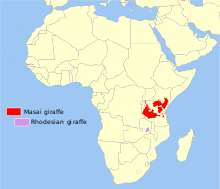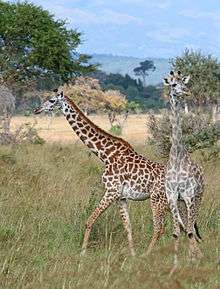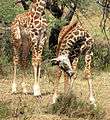Masai giraffe
| Masai giraffe | |
|---|---|
| | |
| Not evaluated (IUCN 3.1) | |
| Scientific classification | |
| Kingdom: | Animalia |
| Phylum: | Chordata |
| Class: | Mammalia |
| Order: | Artiodactyla |
| Family: | Giraffidae |
| Genus: | Giraffa |
| Species: | G. tippelskirchi |
| Binomial name | |
| Giraffa tippelskirchi (Matschie, 1898) | |
 | |
| Maasai Giraffe range in red and purple | |
| Synonyms | |
|
G.c. thornicrofti or G.t. thornicrofti (Lydekker, 1911) | |
The Masai giraffe (Giraffa tippelskirchi), also spelt Maasai giraffe, also called Kilimanjaro giraffe, is the largest species of giraffe and the tallest land mammal.[1] It is found in Kenya, Tanzania, and Zambia. Once considered a subspecies of the conglomerate Giraffa camelopardalis species, in 2007 and 2016 studies identified the Masai giraffe as a separate species of a reorganised Giraffa genus.[2][3] The Rhodesian giraffe (formerly G. c. thornicrofti) was once considered a separate subspecies, but after genetic analysis it has been subsumed as an ecotype into the Masai giraffe species.[2] Overall, the approximate number of all populations accumulate to 32,550 in the wild, with 550 being of the Rhodesian phenotype.[2]
Description
The Masai giraffe is distinguished by jagged spots on its body, geographic range including southern Kenya, all of Tanzania, and the Luangwa Valley in Zambia, and genetic evidence.[2][3] It is the largest-bodied giraffe species.[1]
Conservation
The Masai giraffe population declined 52% in recent decades.[4] Demographic studies of wild giraffes living inside and outside protected areas suggest low adult survival outside protected areas due to poaching, and low calf survival inside protected areas due to predation are the primary influences on population growth rates.[5][6] Survival of giraffe calves is influenced by the local presence or absence of long-distance migratory herds of wildebeest and zebra.[7] In situ conservation of Masai giraffes is being done by several government agencies including Kenya Wildlife Service, Tanzania National Parks, Zambia Wildlife Authority; and non-governmental organizations including PAMS Foundation, Wild Nature Institute, and Giraffe Conservation Foundation. At the several zoos, Masai giraffe have become pregnant and successfully given birth.[8]
Gallery
-
.jpg)
Masai giraffe in Serengeti National Park, Tanzania
-
Detail of head, taken at Cincinnati Zoo and Botanical Garden
-

Two Masai giraffes in Mikumi National Park
-

Two, week-old Masai giraffes in Serengeti, Tanzania
References
- 1 2 Dagg, A.I.; Foster, J. B. (1982). The Giraffe. Its Biology, Behavior, and Ecology (with updated supplementary material). Malabar, Florida: Krieger Publishing Company.
- 1 2 3 4 Fennessy J.; Bidon T.; Reuss F.; Kumar V.; Elkan P.; Nilsson M.A.; Vamberger M.; Fritz U.; Janke A. (2016). "Multi-locus Analyses Reveal Four Giraffe Species Instead of One". Current Biology. 26: 1–7. doi:10.1016/j.cub.2016.07.036.
- 1 2 Brown, David M.; Brenneman, Rick A.; Koepfli, Klaus-Peter; Pollinger, John P.; Milá, Borja; Georgiadis, Nicholas J.; Louis, Edward E.; Grether, Gregory F.; Jacobs, David K. (2007-01-01). "Extensive population genetic structure in the giraffe". BMC Biology. 5: 57. doi:10.1186/1741-7007-5-57. ISSN 1741-7007. PMC 2254591
 . PMID 18154651.
. PMID 18154651. - ↑ Bolger, D. et al. (2015) Masai giraffe conservation status report: IUCN SSC Giraffe and Okapi Specialist Group.
- ↑ Lee, Derek E.; Bond, Monica L.; Kissui, Bernard M.; Kiwango, Yustina A.; Bolger, Douglas T. (2016-05-11). "Spatial variation in giraffe demography: a test of 2 paradigms". Journal of Mammalogy: gyw086. doi:10.1093/jmammal/gyw086. ISSN 0022-2372.
- ↑ Lee, D. E.; Strauss, M. K. L (2016-01-01). Reference Module in Earth Systems and Environmental Sciences. Elsevier. ISBN 9780124095489.
- ↑ Lee, Derek E.; Kissui, Bernard M.; Kiwango, Yustina A.; Bond, Monica L. (2016). "Migratory herds of wildebeests and zebras indirectly affect calf survival of giraffes". Ecology and Evolution. doi:10.1002/ece3.2561. ISSN 2045-7758.
- ↑ Gregory, Kim Lamb (May 10, 2014). "Mothers' nature in the animal world" Ventura County Star
External links
-
 Media related to Masai Giraffes at Wikimedia Commons
Media related to Masai Giraffes at Wikimedia Commons -
 Data related to Giraffa camelopardalis tippelskirchi at Wikispecies
Data related to Giraffa camelopardalis tippelskirchi at Wikispecies